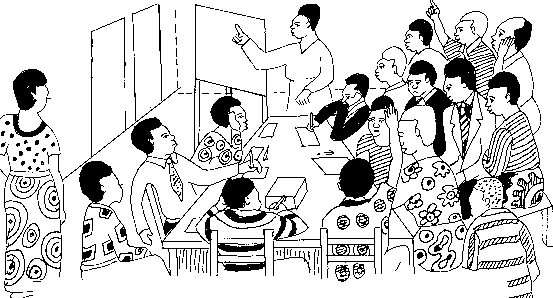Tweet
Translations:
'العربية / Al-ʿarabīyah
Català
中文 / Zhōngwén
English
Español
Filipino/Tagalog
Français
Ελληνικά / Elliniká
Italiano
Português
Română
Српски / Srpski
Türkçe
Other formats:
Other Pages:
Modules
Site Map
Key Words
Contact
Utility Documents
Useful Links
WATER AND PUBLIC AWARENESS
Community Participation in a Campaign
By Phil Bartle, PhD
Dedicated to Andrew Livingstone
Training Handout
Water alone will not reduce disease and poverty; an effective awareness campaign to accompany it must be organized and implemented by the community
Informing the Community:
Water is a very important sector in community empowerment. Constructing or rehabilitating a community water supply facility, however, is not simple, has many unexpected implications, and must be well understood by you the mobilizer, and the community you wish to mobilize.
- Water alone will not decrease disease, nor reduce poverty;
- A campaign of water-borne disease understanding must be included with water supply;
- A change in behaviour is needed to keep water pure from tap to mouth;
- Sanitation must be included if water is to promote health;
- People must understand why they are doing, as well as how to do it;
- A water supply is an investment not a consumer good;
- Providing water is not free;
- Myths that water should be free need to be debunked;
- Giving a community free water promotes dependency and perpetuates poverty;
- Communities that contribute to their water supply will more likely maintain it;
- Politicians must be understood by the mobilizer;
- Politicians can help empower a community but are predisposed to promote dependency;
- Water committees should be transparent in their decisions and finances;
- Communities must organize any awareness raising campaigns;
- Communities need to learn how to manage their water supplies;
- Communities must decide the appropriate sources of water;
- Communities must decide the appropriate technology for providing water;
- No single technology is best for every condition;
- Communities are advised to have a mix of technologies;
- Communities should calculate per capita costs of supplying water;
- Communities must decide how to recover costs;
- Communities must decide if fees or rates should be used;
- Communities must distinguish between capital costs and operating costs;
- Communities must manage their own water supply facilities.
As a mobilizer, you, and your agency (NGO, government, whatever) should not undertake to plan and implement an awareness campaign. It must be an integral part of any water programme, and it should be done by the community. You can provide encouragement, stimulation, challenge and training for the community to undertake such a campaign, but you should not provide the campaign.
Constructing or rehabilitating a water supply facility is a social investment. It requires sacrifices at first, the channelling of resources into activities that are not direct consumption, in order to increase future consumption. It helps to reduce disease, reduce poverty, and increase power and wealth of the community, but only so long as all these issues are part of the total package.
Use the principles of empowerment and the techniques of mobilization explained elsewhere in this series of training modules, to enable community to do it.
––»«––
Organizing a Poster Campaign:
 |